With the reopening of theatres and concert halls, after a long time we are able to see live performances again. We can experience the joy of physically entering a public space of performance and taking in the atmosphere and the architecture. Most of us look forward to the feeling of anticipation that arises when you sit in your seat and the show is about to begin.
Step inside: “a triumph of artistic lightness and elegance”
150 years ago, when the Royal Albert Hall first opened, it was no different. Indeed, a feeling of wonder must have taken hold of spectators when they entered such a large, impressive space. It was unlike anything they had seen before.
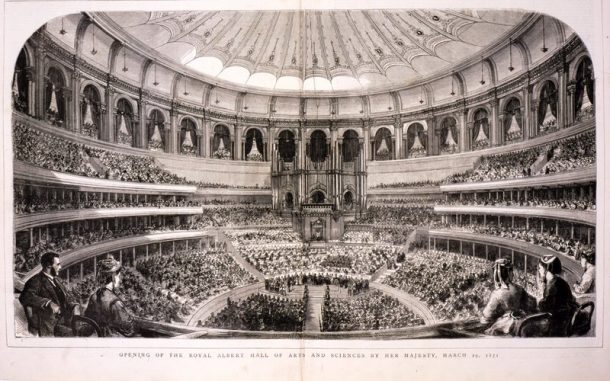
The interior of the Hall was, to be frank, not quite finished. As a matter of fact, Queen Victoria had asked for the opening to be brought forward by a couple of months. Consequently, carpenters, painters, upholsterers, architects and all sorts of building trades specialists had been working around the clock for weeks to be ready by March 27th. Such hard work paid back. Eyewitness accounts remarked on the profound impression the space produced.
It would take several years before the interior decoration could shine in its completed form. Meanwhile the committee held long discussions over the colour scheme. In spring 1871, however, crimson was the dominating colour inside the Hall. A bright shade characterised the box curtains, while a darker hue was prominent in the galleries and amphitheatre.
Seating in the Royal Albert Hall: ‘an almost medieval appearance’
Contemporary commentators noted the effect of the colour in combination with other details both of the accessories and the architecture. The Sun and Central Press, for example, on 13 April 1871 wrote:
The effect of the dark crimson of the upholstery, studded with brass nail, and of the ebony woodwork of the chairs gave an almost medieval appearance to the building, an appearance which was considerably heightened by the tall and burnished metal columns of Mr. Willis’s great organ.
Sun and Central Press, 13 April 1871, p. 13
The seats were the results of careful considerations and an effort towards innovative designs. Eventually, two different kinds characterised the Hall. The balcony, not always in use as a seated viewing station, featured foldable chairs (fig. 2), not unusual at the time.
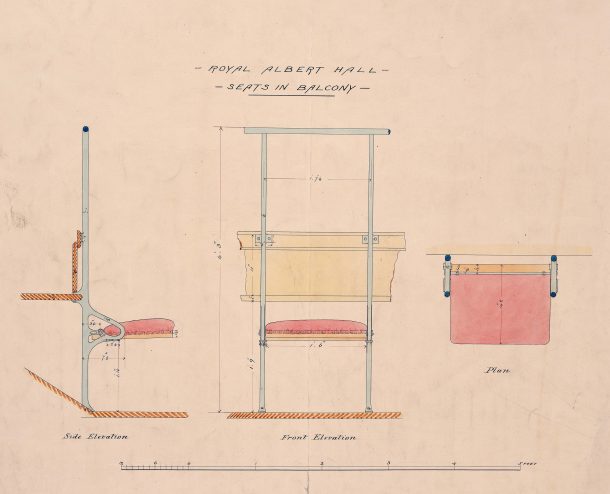
User-oriented Experimental Design
Meanwhile, in the amphitheatre, where over 1300 seats stood in ten rows, the chairs had a very different design. Henry Cole (1802–82), the master mind behind the Hall’s construction, designed them personally. In fact, in December 1870, he was working on an ‘Xperimental chair for Hall’. Subsequently, in early January 1871, he conducted further trials. The resulting ‘roundabout’ chairs rested on a central iron leg. Thus, users could easily turn without touching their neighbours (fig. 3).
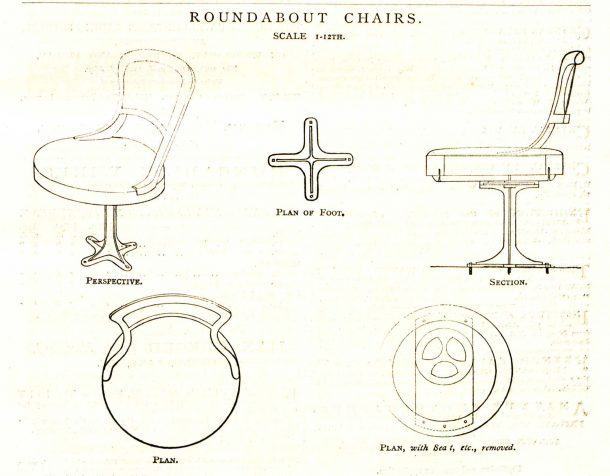
At this time the Essex Standard described Cole’s revolving chair as “an ingenious contrivance”, a novelty that provided audiences undeniable convenience:
To make room for a late comer to pass it is only necessary to turn one’s knees aside by slight revolving the chair. This appears to be a much simpler plan than the old fashioned way of getting up and stepping back into a lift-up seat.
‘Royal Albert Hall of Arts and Sciences’, Essex Standard, 31 March 1871.
Disseminating Good Design
Indeed, the design was innovative, and it seems Cole was very proud of it. So much so that, exactly 150 years ago, in May 1871, he published details of his invention. They appeared in The Key, a “Programme and Record of the London International Exhibitions” (fig. 4).
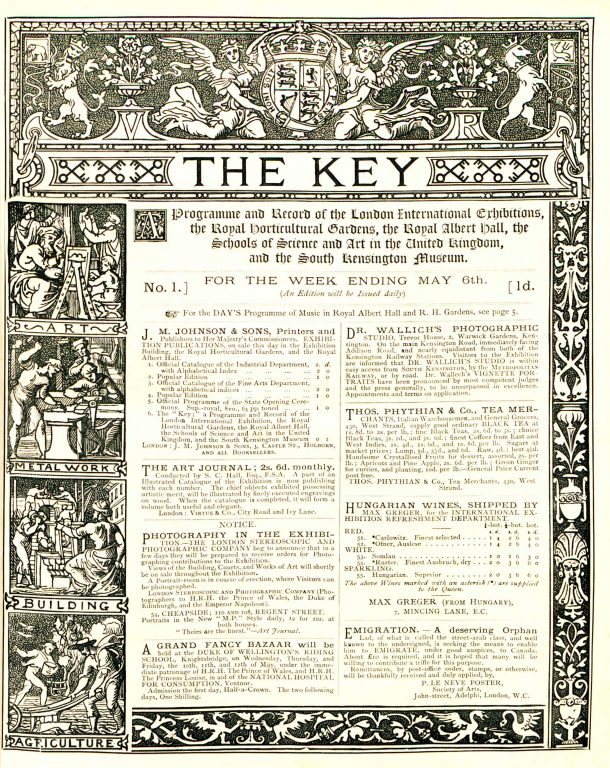
Each issue of The Key covered the program of music and events planned for the1871 International Exhibition for a week. It costed one penny. Up-to-date editions were printed daily in the exhibition. Thus visitors could observe modern printing techniques in action. Furthermore, the programme featured official notices, as well as, occasionally, short articles. Amongst these, repeated in many editions, one presenting Cole’s chair.
The Albert Hall: An Exhibition Building
But what was the link between the Albert Hall and the exhibition? Truly a very strong one. Notably the Albert Hall’s supporters originally planned it not exclusively as a concert venue. It was to be a multi-purpose building. The project was part of a larger scheme to create a centre for the fostering of art, science and industry in South Kensington. Its main propounder was Henry Cole.
Significantly, after the official opening on 29 March 1871, the first regular use of the Hall was in connection with the International Exhibition. It opened on 1 May and occupied a number of sites in and around the Albert Hall. Additionally to the exhibition buildings it extended to the Horticultural Gardens, the South Kensington Museum and the Albert Hall (fig. 5).
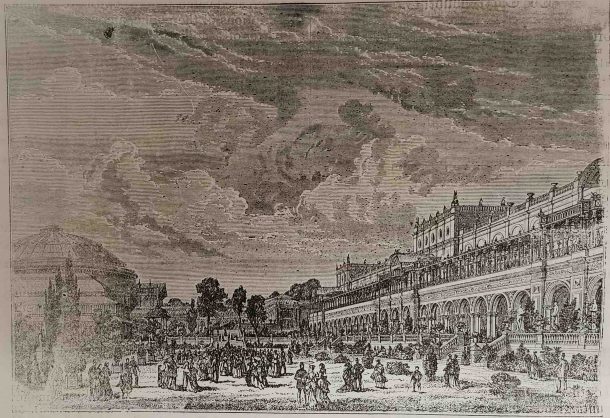
The Albert Hall hosted different parts of the 1871 Exhibition. In the picture gallery the public could admire architecture, engravings, photography and water colours. Additionally, the small theatres showcased teaching apparatuses. Meanwhile the exhibition of woollen and worsted manufactures took place in the South rooms. Finally, the ground floor of the West galleries hosted machines in motion.
Henry Cole: The Director-designer
Henry Cole was no stranger to design practice. His working life centred around his activities as a civil servant. In particular he was involved in a great many projects for reforming public services in the Kingdom: from the record office, to the postal service. Furthermore Cole acted as one of the main driving forces behind the Great Exhibition of 1851. He was a great believer in the necessity of educating both consumers and productive classes in art, design and technology.
In parallel to such policy activities, however, Cole also enjoyed developing designs of his own. In this field he acted under the pseudonym Felix Summerly. One famous example of Cole’s own creations is a tea set now in the V&A’s collections. He designed it in 1846 and subsequently commercialised it with the firm Minton (fig. 6).
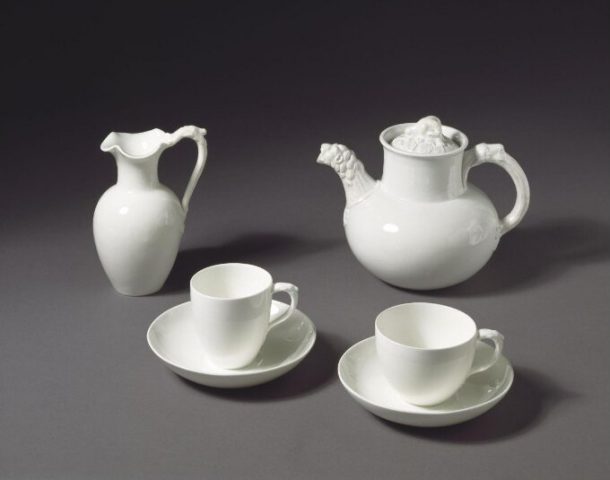
According to Cole, it “had as much beauty and ornament as is consistent with cheapness.”
This was in line with Cole’s ambition to disseminate good design in a variety of ways including through formal education and the activities of the museum. To this effect Cole, in 1847, founded the Felix Summerly Art Manufacture. The firm aimed at producing small-scale works of art designed by contemporary artists.
Cole’s design for the Royal Albert Hall’s chairs is a further example of such attitude. It was an attempt to foster the production of aesthetically pleasing objects as well as functional items for the ‘modern’ world. The whole Albert Hall building, in fact, had this ambition and was conceived as an ‘experimental’ model building.
To know more about the unique characteristics and background of the Royal Albert Hall…
… you can read other posts in this series. These are an outcome of the Leverhulme Trust funded Project Designing the Future: Innovation and the Construction of the Royal Albert Hall. The full story of the Albert Hall’s construction will be narrated in the forthcoming monograph The Royal Albert Hall: Building the Arts and Sciences.



It was a brilliant blog . I liked the fact that Henry Cole created his own chairs for the Royal Albert Hall. It was a medieval blog